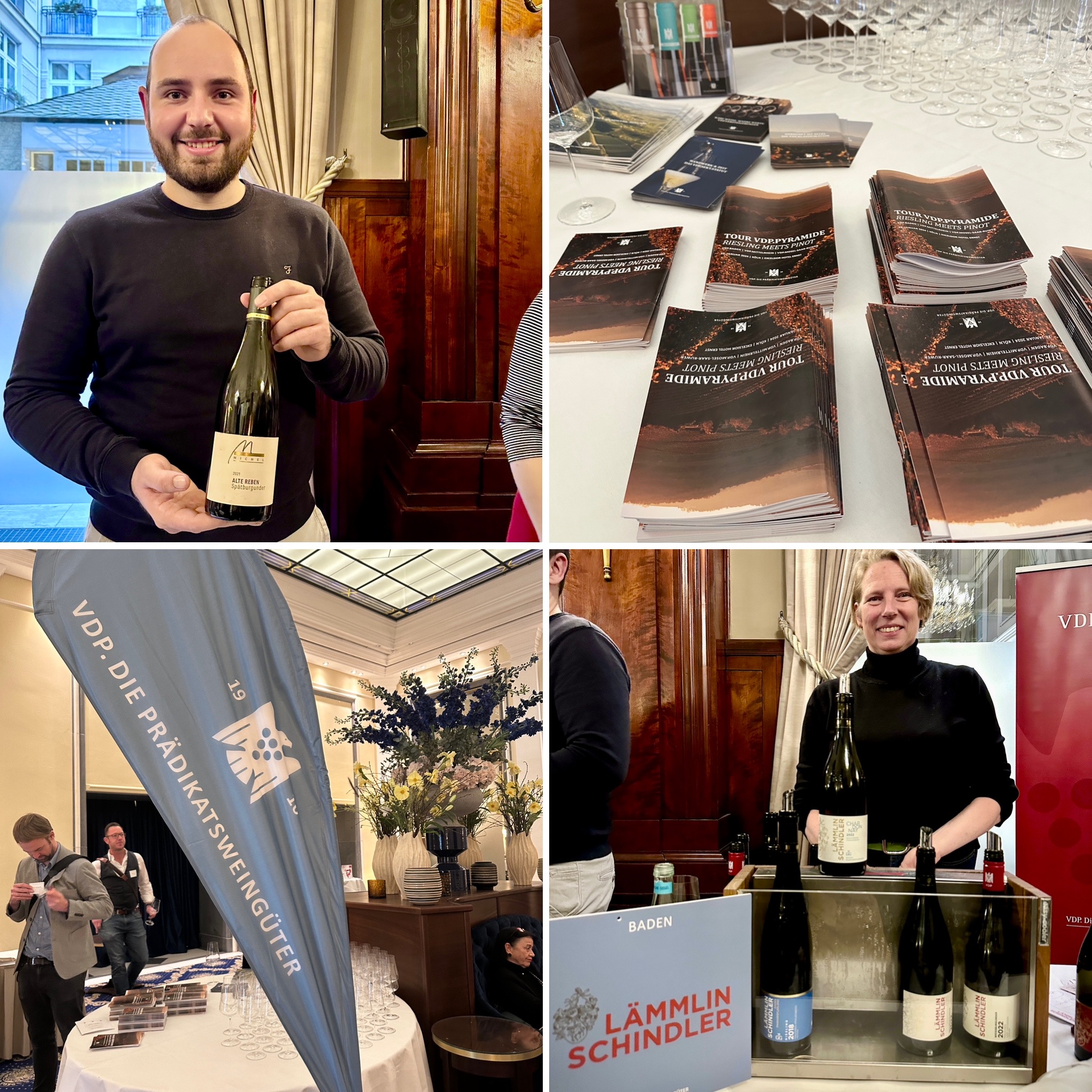Riesling Meets Pinot – VDP Tour 2024.
Located near the stunning Cologne Cathedral in Germany, our own Kazumi participated in a VDP tasting last January, highlighting VDP.BADEN, VDP.MITTELRHEIN, and VDP.MOSEL-SAAR-RUWER. This event, 35 wineries joining with more than 300 wines, provided invaluable insights into each region’s unique characteristics, which contrast with each other.
Since the event was limited to three regions, we had the opportunity to take a deep-dive into each region, and experience the differences between the vineyards and wineries. This article highlights regional overviews for our readers, particularly the Mosel-Saar-Ruwer and Baden regions, with highlights from a number of wineries that showcased exceptional wines.
Verband Deutscher Prädikatsweingüter
The VDP (Verband Deutscher Prädikatsweingüter) is a private organization championing high-quality wines with around 200 members across the main wine-producing regions. The system, akin to the one used in Burgundy, designated Grand Cru and Premier Cru vineyards and is classified with four tiers: VDP.GUTSWEIN (regional wines), VDP.ORTSWEIN (Village wines), VDP.ERSTE LAGE® (Premier Cru), and VDP.GROSSE LAGE® (Grand Cru). If you are interested in learning about VDP more, the following articles are also recommended. (VDP.WEINBÖRSE 2023, New updates in Germany’s VDP Classification System)
Regional Overviews
Mosel (sometimes called Mosel-Saar-Ruwer) and Baden, despite both having similar slender and elongated shapes, exhibit distinct characteristics as Germany’s northern and southern regions. In our next chapters we will take a deeper look at each region, represented by a selection of producers and their wines.

MOSEL-SAAR-RUWER
Situated at 49-50°N, Mosel-Saar-Ruwer is one of the northernmost wine-growing regions. Regarding production volume, whites dominate over 90 percent of plantings, and Riesling, which has a worldwide reputation, alone constitutes over 60 percent.
Stretching alongside the meandering Mosel River for 250 km, half of the vineyards are perched on terraced sites with slopes exceeding 30 percent, while some are planted on gradients as steep as 70 percent. From the top, the panoramic view of the Mosel River weaving through the vineyards is truly breathtaking, yet managing vineyards on such steep slopes can be daunting. Wooden stakes on these precipitous inclines support vines, and nearly all grapes must be handpicked, demanding significant work. The Saar and Ruwer, tributaries of the Mosel at higher altitudes, boast cooler temperatures, but some vineyards face directly south, and grapes ripen well depending on the vineyard’s orientation.
Mosel-Saar-Ruwer comprises six areas: Grand Cru vineyards are situated on slopes surpassing 30°. The soils are predominantly slate-based, albeit varying across different areas. Exceptional vineyards include (village mentioned first, then vineyards in brackets) Brauneberg (Juffer), Graach (Himmelreich), Ürzig (Würzgarten), and Winningen (Uhlen) in Mosel, along with Kanzem (Altenberg), Kanzem (Hörecker), and Scharzhofberg in Saar, and Eitelsbach (Karthäuserhofberg) in Ruwer.
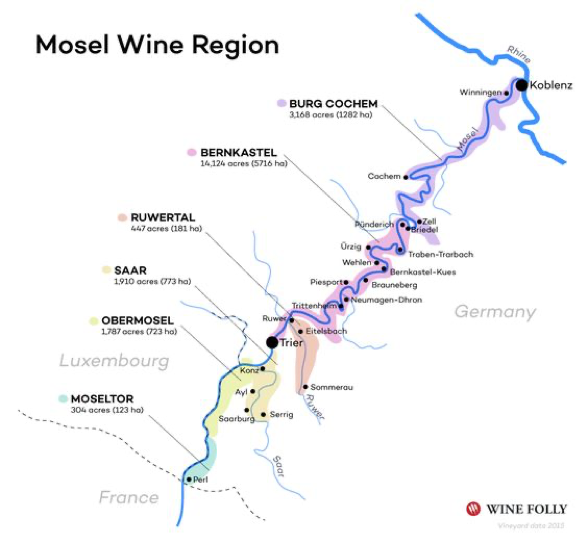
Weingut Heymann-Löwenstein
Heymann-Löwenstein, situated in the Burg Cochem area in Mosel, stands as one of Germany’s most esteemed winemakers, renowned for his mastery in crafting dry Rieslings. Weingut Heymann-Löwenstein boasts some of the finest parcels in Winningen (Uhlen), including Blaufüsser Lay, Laubach, and Roth Lay.
Below a selection of their wines which we tasted at the event.
Kirchberg Hatzenport Riesling 2022|VDP.GROSSE LAGE®️|DWA Score: 92
Kirchberg vineyard in Hatzenport village has reddish, sandy slate, sandy quartzite with iron.
Bright yellow fruits, herbal spices, grapefruits, pear, melon, and lily on the nose. High but integrated acidity. Approachable and balanced at this young age.
Stolzenberg Hatzenport Riesling 2022|VDP.GROSSE LAGE®️|DWA Score: 93
Stolzenberg vineyard is one of the best sights in Hatzenport. More mineral tone rather than fruits. Citrus, peach, fresh herbs, and spices. Rich, savory mouthful on the palate by concentration. Persistent long finish, with citrus and minerality.
Röttgen Winningen Riesling 2022|VDP.GROSSE LAGE®️|DWA Score: 92
Röttgen vineyard in Winningen village has Devonian sediment with blue, sandy slate.
Citrus and bright stone fruits, wet stone, and spices on the nose. Elegant wine with a cool, lean structure. Persistent long finish with citrus and smoky aftertaste.
Schieferterrassen Riesling Beerenauslese 2019|VDP.GUTSWEIN|DWA Score: 92
Schieferterrassen means slate terraces, sourcing grapes from the parcels of their ERSTE LAGE sites. Ripe, juicy stone fruits, distinctive floral notes, a hint of herbs, wet stone, yeast, and nuttiness on the nose. High acidity gives a great balance.

Reichsgraf von Kesselstatt
Reichsgraf von Kesselstatt started its history in the 14th century and now covers 46 hectares in the Mosel, Saar, and Ruwer. Josephshöfer with five hectares is its monopole.
Below a selection of their wines which we tasted at the event.
Josephshöfer Riesling GG 2022|VDP.GROSSE LAGE®️|DWA Score: 95
Josephshöfer vineyard in Graach village is the monopole, with gray, weathered slate with fine earth. Powerful concentrated wines. Peach, Mirabelle plums, fresh pineapple, herbs, and earthiness. Mouthwatering high acidity. Good aging potential.
Josephshöfer Riesling Kabinett feinherb 2022|VDP.GROSSE LAGE®️|DWA Score: 93
Slightly fruitier in style compared to the above, balanced between high acidity and sweetness.
Juffer-Sonnenuhr Brauneberg Riesling Spätlese 2022 |VDP.GROSSE LAGE®️|DWA Score: 94
The Juffer-Sonnenuhr vineyard in Brauneberg village has a steep slope with an 87% gradient, extremely stony soil, Devonian slate, and high clay content. Fruit-driven and concentrated. Supple mouthfeel with high racy acidity.
Weingut Geheimrat J. Wegeler
Weingüt Wegeler has owns estates both in Bernkastel, Mosel and Rheingau since 1882.
Below a selection of their wines which we tasted at the event.
Doctor Bernkastel Riesling GG 2021|VDP.GROSSE LAGE®️|DWA Score: 93
Doctor in Bernkastel is the most famous vineyard in Mosel. It has a stony, weathered Devonian slate with a high proportion of fine earth. Exotic nuances and clear mineral notes. Mirabelle plum, pineapple, ginger, and citrus. Steely acidity and density on the palate.
Doctor Bernkastel Riesling Kabinett 2022|VDP.GROSSE LAGE®️|DWA Score: 91
In this young vintage, acidity is balanced with its off-dry sweetness. Approachable.
Sonnenuhr Wehlen Riesling Auslese 1993|VDP.GROSSE LAGE®️|DWA Score: 94
This vintage Auslese from Sonnenuhr vineyard in Wehlen village was a real treat.
Southerly exposure, with high stone content, gives good soil warmth. Complex nose, with multiple tertiary aromas of sweet spices, hazelnuts, honey, and dried apricots. Racy acidity gives a great balance.
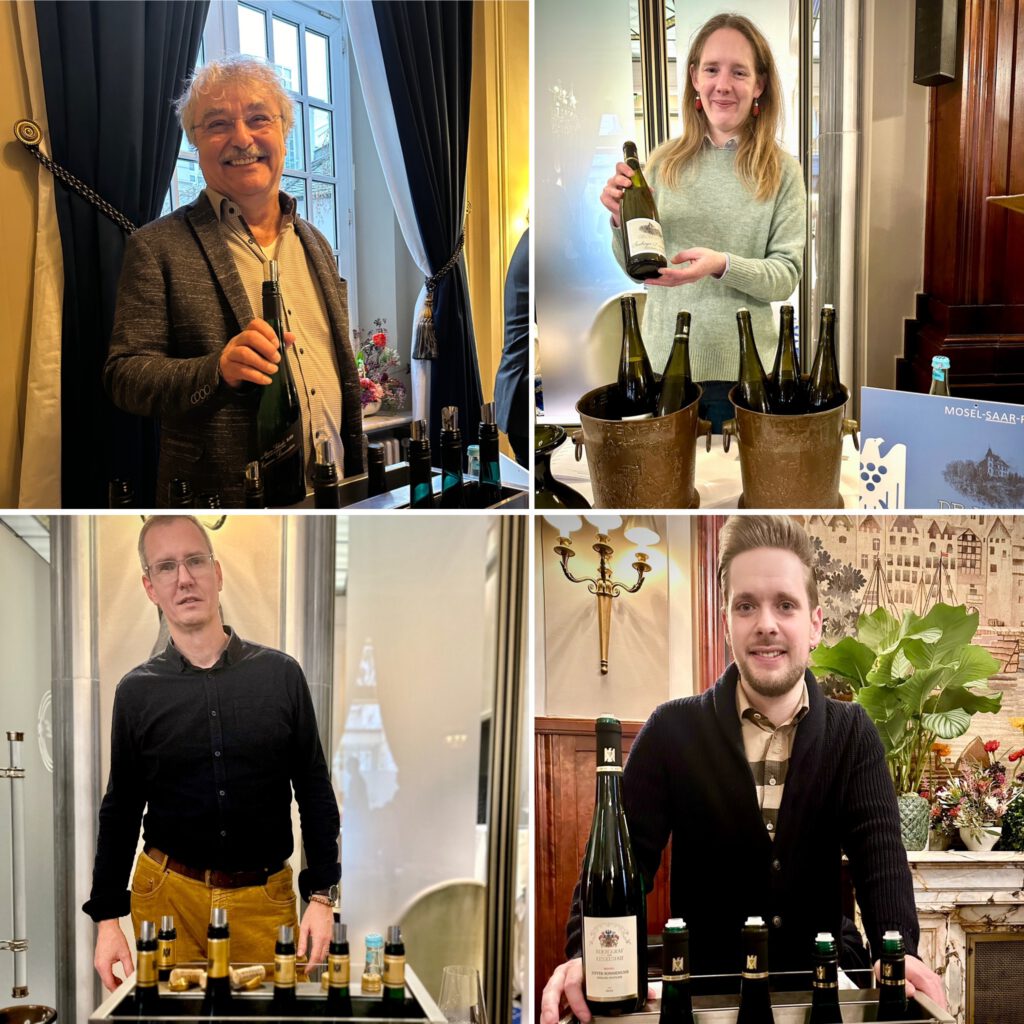
BADEN
Baden is located in the southernmost part of Germany, boasting the country’s sunniest, driest, and warmest climate, whose temperature is close to that of the Mediterranean. This sun-kissed region is known for producing 60 percent red wines and enjoys a stellar reputation, particularly for its Pinot Family: Spätburgunder (Pinot Noir), Grauburgunder (Pinot Gris), and Weissburgunder (Pinot Blanc.)
Baden comprises nine wine districts. The Kaiserstuhl, known as Baden’s sun terrace, boasts even the warmest amongst others and features extinct volcanic soil. This typically results in wines with full-bodied profiles, high alcohol content, and complex, smoky, ripe fruit flavors. In contrast, wines from cooler districts like Ortenau or on calcareous soil, such as Tuniberg and Breisgau, exhibit more acidity and delicate fruit notes. Among the region’s 16 Grand Cru and 306 Premier Cru vineyards, standouts include Neuweier Mauerberg in Ortenau, Achkarren Schlossberg, Oberrotweil Eichberg, and Oberrotweil Kirchberg in Kaiserstuhl as exceptional vineyards.
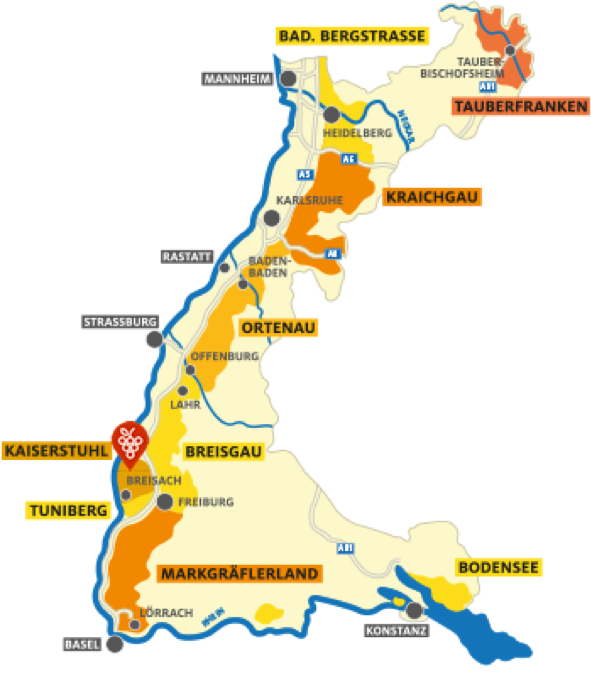
Dr. Heger
In the Kaiserstuhl district, Dr. Heger, who began his winemaking journey as an enthusiastic amateur in 1935, acquired notable vineyards, including the exceptional Achkarren Schlossberg and Ihringen Winklerberg over time. Today, his grandson, Joachim Heger, and his wife, Silvia, oversee the estate, Weingut Dr. Heger. Joachim Heger has served as chairman of the Baden regional association within the Association of German Prädikat Wineries (VDP).
On the day, Marcus, Joachim’s trusted man, was introducing the wines of Winklerberg, among others. Ihringer Winklerberg has a mix of volcanic rock and lime, where wines are typically by mineral tone.
Below a selection of their wines which we tasted at the event.
Ihringer Winklerberg Weissburgunder 2022|VDP.ERSTE LAGE®️|DWA Score: 90
Winklerberg vineyard in Ihringer village has partly alluvial soil mixed with a layer of loess and partially weathered volcanic soil with deep loess terraces. Expressive fruit aromas of citrus, lime, and Mirabelle plum. Fresh acidity. Drink now.
Vorderer Winklerberg Grauburgunder 2021|VDP.GROSSE LAGE®️|DWA Score: 93
Vorderer means front. The front side of the plateau has a rare structure with a thin layer of loess over a weathered volcanic rock. Layered aromas of Mirabelle plums, apricots, nuttiness, orange blossom, and wet stone. Dense fruits are counterbalanced with phenolic grip and acidity structure.
Ihringer Winklerberg Spätburgunder Mimus 2019|VDP.ERSTE LAGE®️|DWA Score: 92
“Mimus” is the nickname of the current owner’s father. Intense dark fruits include fully ripe black cherries, cassis, violet, and cloves. Structured by refreshing acidity and close-knit tannins.
Vorderer Winklerberg Spätburgunder 2018|VDP.GROSSE LAGE®️|DWA Score: 96
Burgundian style with French clone. Intense aromas of fully ripe cherries, wild berries, violet, cloves, cinnamon, and thyme. Supple, warm, full body on the palate, structured by velvety tannins and refreshing acidity. Persistent long finish with wet stone-like minerality. Long aging potential.

Weingut Lämmlin-Schindler
Weingut Lämmlin-Schindler, situated in the Markgräflerland district in the south, boasts a rich history dating back to the 12th century. Since 1989, they have transitioned their cultivation practices to organic methods.
Below a selection of their wines which we tasted at the event.
Frauenberg Chardonnay 2022|VDP.GROSSE LAGE®️|DWA Score: 93
Frauenberg vineyard in Mauchen village has loess loam, humus, and lime soil.
Citrus, herbal, and subtle spice notes. A supple attack having a medium body with refreshing acidity. Elegant Chardonnay with minerality and saltiness on the palate.
Mauchener Sonnenstück Spätburgunder 2018|VDP.ERSTE LAGE®️|DWA Score: 90
Sonnenstück vineyard is divided by several villages, and the wine sources grapes from Mauchen. Black fruits, spices, smoke. Earthy and fuller-bodied Pinot Noir.
Frauenberg Spätburgunder 2019|VDP.GROSSE LAGE®️|DWA Score: 93
Frauenberg vineyard in Mauchen. Very dense and lush Pinot Noir with black fruits and subtle spice. Velvety tannins. Still youthful and need time, yet balanced.
Weingut Bercher
Weingut Bercher, situated in Burkheim, Kaiserstuhl, extends its vineyards across several villages.
Below a selection of their wines which we tasted at the event.
Burkheimer Feuerberg Grauburgunder 2022|VDP.ERSTE LAGE®️|DWA Score: 91
The Feuerberg vineyard in Burkheim village has dark, weathered volcanic soil and features loess on the foot slope. Lemon, grapefruits, and a hint of spice on the nose. Fresh acidity, rounded mouthfeel, and saltiness on the palate.
Sasbacher Limburg Spätburgunder 2019|VDP.ERSTE LAGE®️|DWA Score: 92
Limburg vineyard in Sasbach village, that has a high concentration of Loess soils. 24 months aging in oak barrels. Juicy Pinot Noir, with sour and sweet cherries, berries, spices, and figs.
Fuerberg Kesselberg Spätburgunder 2021|VDP.GROSSE LAGE®️|DWA Score: 94
Spätburgunder wines from Feuerberg vineyard in Burkheim village tend to be structured and full bodied. It is youthful and needs time to open, yet it has great fruit concentration. Subtle oak with less spiciness, not overpowering the fruits. Balanced with refreshing acidity.
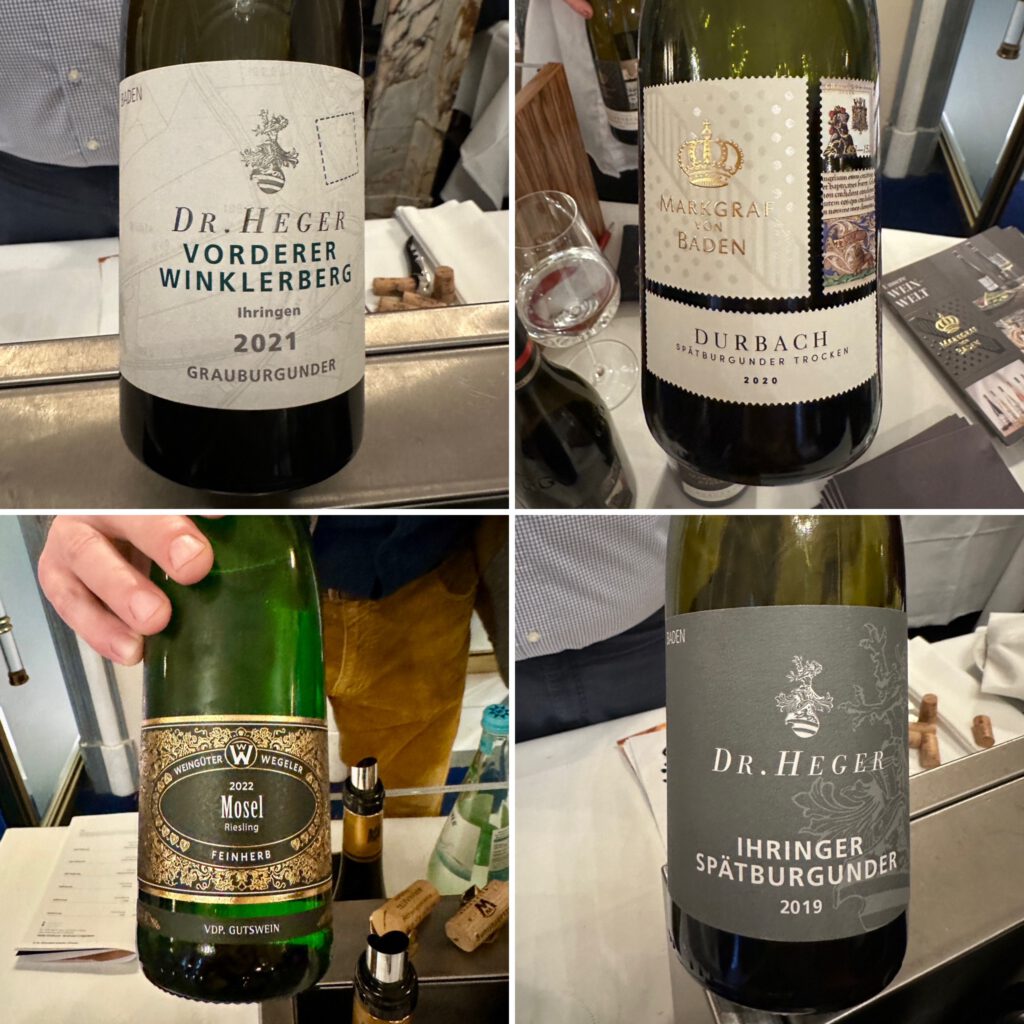
Riesling Meets Pinot: Unveiling Excellence Across Germany’s VDP Vineyards.
It was a fantastic chance to explore the distinct differences between two specific regions. Riesling was once synonymous with German wines, but now, other varieties like the Pinot family and Chardonnay are also making their mark.
Especially considering the high standards set by the VDP for quality, there’s a good chance you will discover a new favorite here. If you are on the hunt for a top-notch Riesling or Spätburgunder, just make sure to look for the VDP eagle on the label, and you won’t be let down!
This event was covered by our own Kazumi Uejo. We would like to thank all wineries present at the event and the VDP for the excellent organization and their hard work and commitment towards German wines.
*The soil information cited comes directly from the ‘Wine Atlas of Germany’.

